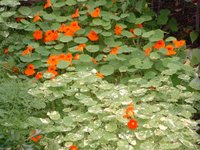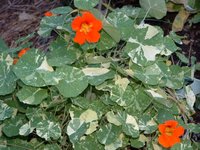Nasturtiums are one of my favorite edible flowers for growing to compliment the vegetable or herb garden. Tasty, attractive, and easy to grow, nasturtiums also perform well in containers. The blossoms range from bright red, to apricot, yellow, peach, salmon, pink, orange, gold, cream, or mahogany.
Some nasturtiums have a mounding growth habit best suited for garden plantings or containers. Others display a vine-like habit, best treated as trailing plants and grown in hanging baskets, wall containers, or allowed to ramble up supports.
Using Nasturtium’s Edible Flowers and Leaves
 With their peppery flavor, nasturtium flowers are great for spicing up the taste and appearance of leafy green mixed salads. You can also add the blossoms to omelet recipes, potato and pasta salads, and cream cheese spreads or dips.
With their peppery flavor, nasturtium flowers are great for spicing up the taste and appearance of leafy green mixed salads. You can also add the blossoms to omelet recipes, potato and pasta salads, and cream cheese spreads or dips.
The one inch wide, circular leaves are edible as well, with the same peppery flavor as the flowers. Treat nasturtium leaves like the blossoms and include in tossed salads, or chop and use as an herb to spice up your favorite recipes.
Tips for Growing Nasturtiums
Planting nasturtiums is as simple as poking a hole in the soil with your finger and dropping in one of the rather large seeds. Start indoors and transplant to the garden, or sow directly in the garden after the danger of frost has passed. Quick to germinate, a spring planting will reward you with a harvest of blossoms from the start of summer until fall frosts.
Nasturtiums do not require rich soil and if over fertilized will produce leaf growth at the expense of flower production. Because they are fast growing, you can make additional plantings during late spring and during the summer.
They make a good plant to use for filling in bare spots throughout the garden or along the edges of your flower and vegetable beds. A single nasturtium seed will produce a spreading plant with lush foliage covering a two square foot area.
Interesting Nasturtium Varieties

Favorite varieties include: Whirlybird Mix, Empress of India, Dwarf Jewel Mix, King Theodore, Milkmaid, Salmon Baby, and Canary Creeper. The “Alaska Mixed” variety is favored for its ornamental leaves, which are an unusual marbled green and white in color with bright flowers in an assortment of colors.



7 Responses
There is an interesting recipe by former president Eisenhower (he was apparently an avid cook) for vegetable soup that uses nasturtiums. Here is the url:
http://www.eisenhower.archives.gov/soup.htm
There is an interesting recipe by former president Eisenhower (he was apparently an avid cook) for vegetable soup that uses nasturtiums. Here is the url:
http://www.eisenhower.archi…